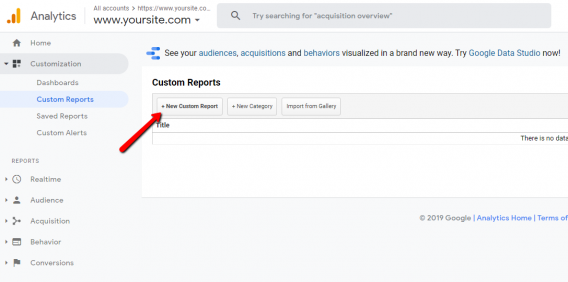What’s more important, traffic or conversions? If you send me 50k people from a classic tractor repair website and 500 from a prominent marketing site, which one is going to be better for my business?
Unless you’re in the pageview business, you should first and foremost care about conversions. Conversions take place when targeted traffic meets relevant offer. It all starts with doing your persona research and understanding what your customers need or want.
The aim of marketing is to know and understand the customer so well the product or service fits him and sells itself.
– Peter Drucker, influential business thinker of the 20th century
So how can you target the right customers online?
If you want to increase conversions, you have to figure out who exactly is your primary target audience, what they want, what matters to them, and what are the sources of friction for them.
If you say your website target audience is “pretty much everybody” or “anyone interested in my services,” you don’t have much of a chance to boost conversions.
Table of contents
Why identifying your target audience matters
If you know…
- Who the people are, you know how to get to them (the blogs they read, the sites they visit, the stuff they search in Google, etc.);
- How they describe the type of services you offer, you can word the copy on your site to match the conversation in their head (very important!);
- How they choose and compare products in your category, you know how to structure and prioritize content on your site;
- What they want, your value proposition can state exactly that and the whole site can be 98% relevant to them;
- What they don’t care about, you can dismiss and cut it from the site;
- How their life is better thanks to your service, you know which end-benefits to communicate.
It’s all about relevancy—if what you offer and how you present it matches their state of mind, you have gained a customer.
If your customer is “everybody,” you’re making it extremely difficult for yourself—nobody identifies with “everybody.”
If you don’t have hard data, start with assumptions
If you have no paying customers yet, you’re dealing with assumptions and educated guesses based on your first-hand experience and anecdotal evidence.
Traditionally, defining a target audience involves determining their age, gender, geographic locations, and their needs. The data you need to know depends on the product and whether you have a B2B or B2C business.
This approach, however, is not very helpful. Online, the location matters much less (if at all). Age is not what it used to be—fifty-year-olds get just as excited about new tech gadgets as twenty-somethings, and 30-year-olds may still be living with their parents. More than demographic data, you want to look at the lifestyle.
You want to have answers to these questions:
- Who are the target customers? How would you describe their life (or business) situation?
- What do they want? What’s the pain?
- What are their needs that aren’t being met?
In order to have a business case, you also need to think about market size and disposable income as well. You might have a problem/solution fit, but it doesn’t necessarily mean you’re in the money.
Talk to people
“There are no facts inside your building, so get outside,” is one of the mantras of Steve Blank, the father of customer development and author of The Startup Owner’s Manual. When I talk to people starting a new business and they complain about conversions, the first question I ask is, “How many customers have you talked to?” Usually, the answers is “None.”
Once you have your first customer profile written down, go out and meet these people or businesses. Talk to them, observe them in their natural habitat, and learn all you can.
Austin-based startup Food On The Table started with a target market assumption. Then they found a mom who plans meals and uses coupons, and spent three weeks shadowing her as she made lists and pushed her cart around the local supermarket. Her feedback helped create the first version of the website.
Not long after that, they’ve reached 1 million users and were later acquired by Food Network. Talking to your customers pays off.
What if you learn that your current business assumptions are wrong?
It’s not uncommon that a company starts with an assumption of who the target audience is and what they want, and changes course once they learn more about the market. In the Lean Startup methodology, it’s called a pivot.
Many well-known companies have changed direction, from PayPal to Groupon. Here’s a summary of 10 types of pivots.
If you’re just starting out and figuring out how to grow to the next phase, make sure to check out The Lean Startup, a book by Eric Ries.
Survey your customers
If you have paying customers, the best thing you can do is to survey them. What you want is to get in the heads of your customers to learn why and how they buy.
Don’t survey all of your customers. Focus on the last 20 (minimum) to 100 (maximum) who still remember their purchase experience. If you ask somebody who made the purchase six months or more ago, they have long forgotten and might feed you with false information.
I recommend asking the following questions (adjust the wording as you see fit):
- Who are you? Get the demographic data and see if there are any trends (e.g. generational). If you’ve got a B2B business, ask about their industry and position in the company (and who makes purchase decisions).
- What are you using [your product] for? What problem does it solve for you? Here you want to make sure you understand their problem. You might discover some unintended uses as well.
- How is your life better thanks to it? Which tangible improvements in your life or business have you seen? This will tell you the end-benefit your product provides in the words of your customers. If some say really nice things, hit them up for testimonials or case studies.
- What do you like about our product the most? Learn what your customers think is the best part of your product, and mention it prominently in your copy.
- Did you consider any alternatives to our product (prior to signing up)? If so, which ones? You want to know who people compare you to. Next step is that you need to build a “compare” page where you compare yourself to the competition and make a case for your advantages.
- What made you sign up for our product? What convinced you that it’s a good decision? Why did you choose us over others? You want to know what’s working for you in your current website and identify some advantages you might want to emphasize more.
- Which doubts and hesitations did you have before joining? Identify main sources of friction, and address them (or fix them if they’re usability problems).
- Which questions did you have, but couldn’t find answers to? Some 50% of the purchases are not completed due to insufficient information. This helps you identify some of the missing information your customers want.
- Anything else you would like to tell us? Leave room for feedback you don’t know to ask.
- What else would you like to buy from us (if we were smart enough to offer it)? This will give you ideas for new products or services your customers are ready to pay for.
Feel free to include some that are specific to your business.
Tips for the survey
If you can, keep it short: the more questions, the fewer responders and poorer quality responses. Write your questions, then weed them out.
Make sure the information you collect is actionable. Don’t ask questions just because you’re curious. Once you have written your questions, go through them and ask yourself: “What am I going to do with this information once I have it?” Make sure each question contributes something unique and is necessary.
Keep it neutral. Try to use language that doesn’t lead the customer any particular way. Imagine that you are taking this survey as a person with a particular set of answers. And then go through again with a different (or opposite) set of responses, and see if the question is easier or harder to answer. Then, adjust the wording to make it neutral.
Avoid multiple choice
Note that all the answers should be free-form, not multiple choice. You want the customers to be able to express themselves without constraints. You don’t know what you don’t know, and multiple choice will never reveal those things.
Another thing you want to pay attention to is how they word things. Your website has to speak the same language your customers do. Notice how they describe the problem, the solution, the benefits.
I often copy and use the exact wording from a survey answer in a value proposition or other key part of the website copy, and it works the best.
Pressure and incentivize
When sending out surveys, remember to put some time limit on them (use a phrase such as “fill this out in the next 3 days”) to get data faster. Reward everyone who answers the survey (free product or service, Amazon gift card).
What you can discover from Google Analytics
If you have correctly set up goals and/or ecommerce tracking in Google Analytics, you can get some insightful data.
Below are some useful reports that show you stuff like which traffic sources convert the best. Invest more time, money, and effort in high-performing traffic senders. Ignore low performers.
If guest blogging is part of your content marketing strategy, pay attention to which blogs send you the best-performing traffic and try to become a regular poster on those blogs.

Google Analytics custom reports are highly useful. Here are some reports you can plug right into your own analytics profile just by clicking on the links.
- Best converting traffic sources. Where is the traffic that converts coming from? Get the Traffic Report.
- Best performing content. Which content works and what doesn’t? Get a clear overview. Get the Content Efficiency Analysis Report.
- Best converting keywords. Which keywords are your money makers? Aim to rank better for these and similar keywords. Get the Keyword Analysis Report.
- Best converting landing pages. Where is the incoming traffic landing on and does it convert? Get the Best Converting Landing Pages Report.
- Ecommerce report. If you run an ecommerce site, you want to see which channels are performing the best. This GA custom report will show you visits per source along with revenue and visit value data. Get the Ecommerce Traffic Report.
More great Google Analytics custom reports here.
Test your assumptions
Learn qualitatively, test quantitatively.
Whatever you learn, your conclusions are still a hypothesis—you need to test them in the real world. If your organic traffic is low, you can run a PPC campaign on Google Ads or LinkedIn (or wherever is a good way to reach your target audience) to get enough people on the site for statistical confidence.
Speed up the time it takes to test assumptions, no reason to waste sales by waiting.
Conclusion
Remember, conversions take place when targeted traffic meets relevant offer. So your job as a marketer is to find the right sources traffic and to make sure your website is relevant for them. Relevancy leads to sales.
Use the findings from talking to people, surveys and analytics data to write the copy on your site and decide on the information architecture. Use it for your product development (and for deciding what to sell in the first place).
When you master finding your target audience online, they’ll look at the content and go “Hey, this is exactly what I’m looking for.” That’s how you’ll know you’ve nailed it.







Great stuff
If you are marketing to everyone, you are marketing to no-one.
Indeed! The point is to connect with the buyer. If you don’t do it, you’re wasting everybody’s time.
Thanks for emailing me about this Peep.
The notion of actually getting out to meet your ideal customers is simple but often overlooked. So often we can end up staring at a computer screen trying to work things out or working off assumption, (which of course is the mother of all expletives!).
I also love your survey questions – I’m going to modify these for my target audience and try to get some feedback.
Cheers!
Loz
Great! Hope it works well.
Excellent article Peep. I have that one bookmarked so I can come back and read it again. I do have to ask, what is that cool corner popup program you are using for building your list? Is that a plugin?
I’d be curious to know, I think it’s great.
Cheers
Davin
Thanks. As Paul already mentioned, it’s Qoate Scroll Triggered Box
This is a really well-written piece. It sums up pretty much everything. Execution is everything – going out and talking to people.
(Btw, there’s a small typo in the “Talk to people” paragraph:
“how many customers have to talked to?”)
Cheers, fixed the typo.
Excellent article. Thank you. Love the Google reports too.
Davin, that corner pop-up is a Qoate Scroll Triggered Box, you can get it here: http://dannyvankooten.com/189/scroll-triggered-box-with-jquery/
Cheers,
Paul
Great post as always – and timely too. I’ve got to survey my customers asap…I assume that if you get on the phone then the responses from just 20 people are of more value than the written replies of 100 (depth and clarity of reply). Do you think this is true, or are 100 answers statistically more significant across the board?
You’ll definitely get much higher quality responses over the phone, and 20 might be enough. You have enough when you start to notice trends, similar answers. Sometimes 10 is enough, sometimes even 50 won’t tell you much new
Peep, those custom reports are KILLER! Thanks :)
Thanks!
Brilliant! I’ve always had an issue with figuring out analytics.
Haha :) Glad to help!
Here is another great source for custom analytics reports:
http://www.customreportsharing.com/
Thanks for sharing.
Pontus, Thanks for sharing!!!
hhmm Informative Post, I having one problem with my site. Many times when i checked for my visitors count in the week or month, showing me very different results on different analytic reports.
How can i get actual analytic reports of my web site ?
The difference comes from how you define a visit and so on. They’re all probably right within their definitions. If the same visitor visits twice within 12 hours, some count it as one visit and some as two visits etc.
Just stick with one analytics service and compare the weeks and months within that particular service.
always actionable advice. great post !
Make your days great
Yassin
Peep, Excellent information!!!!
Is only asking open-ended questions (no multiple choice) a good/bad move? Won’t the response rate considerably decrease as users look at 10+ open text questions?
The incentive/reward given must be worth their time spent answering the survey.
Open-ended questions only, multiple choice is useless and does not help you understand the customer at all. Voice of the customer ftw. Of course you need to reward their time.
I love seeing blog that understand the value. I’m glad to have found this post as its such an interesting one! I am always on the lookout for quality posts and articles so i suppose i’m lucky to have found this! I hope you will be adding more in the future…
This doesn’t talk to any server above all, however rather a web page that focuses on listing down servers that square measure most reliableProxy YouTube